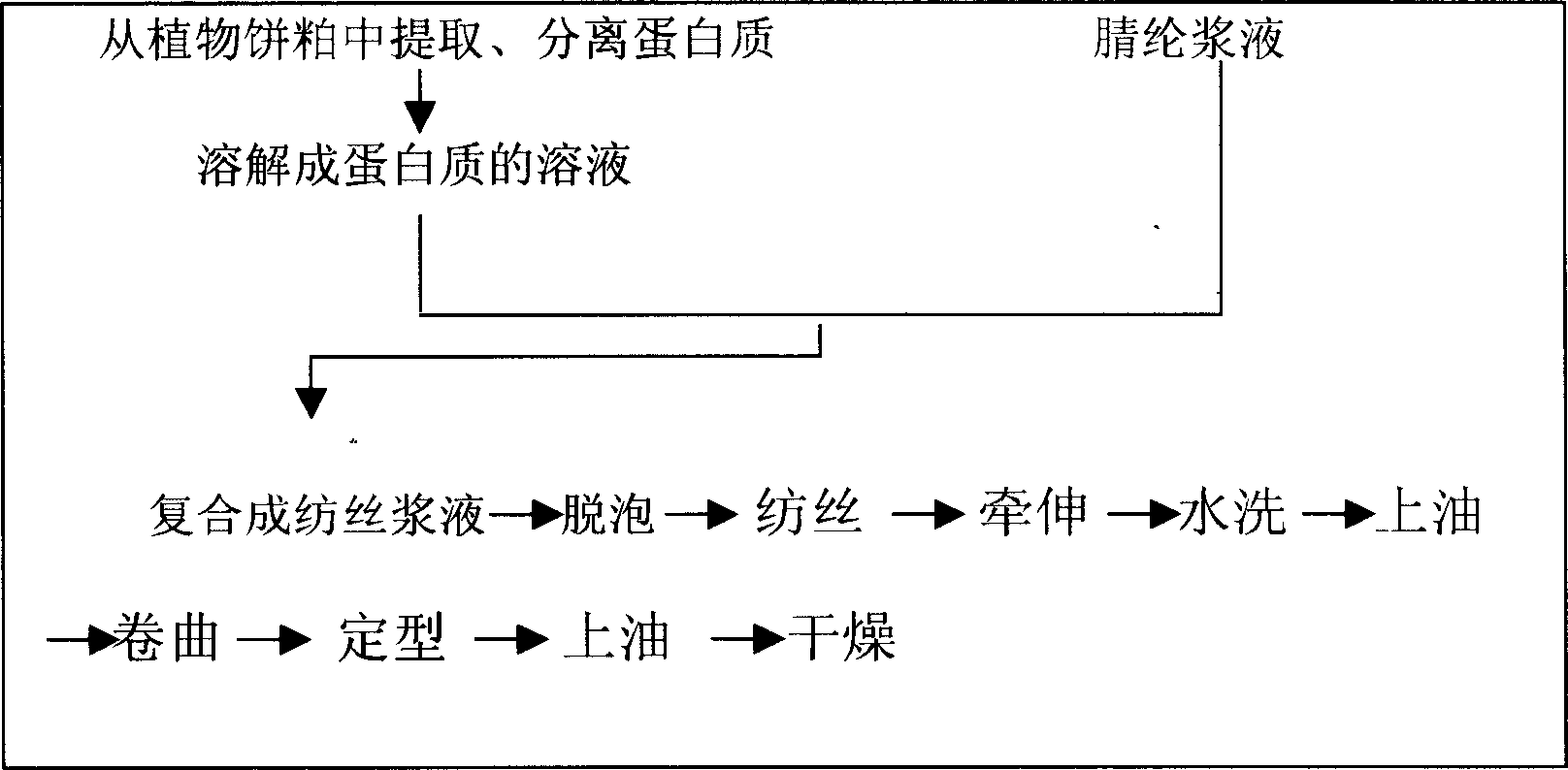Composite fiber of plant protein and acrylon and its manufacturing method
A plant protein and acrylic fiber technology, applied in the direction of cellulose/protein conjugated artificial filament, conjugated synthetic polymer artificial filament, etc., can solve the problems of poor human affinity, high production cost, easy to be charged with static electricity, etc. Achieve the effects of high added value, low production cost, and overcome poor human affinity
- Summary
- Abstract
- Description
- Claims
- Application Information
AI Technical Summary
Problems solved by technology
Method used
Image
Examples
Embodiment 1
[0024] Soybean cake is mixed with 10 times the amount of water, soaked at 30°C for 8 hours, and the insoluble polysaccharide residues are separated, and these residues are mixed with water at a ratio of 1:12, and soaked for 1 hour to separate and remove the residues. The two parts of the solution were combined and the pH value of the solution was adjusted to 4.4 with hydrochloric acid and allowed to stand for 2 hours for acid precipitation. The soluble polysaccharides were separated by centrifugation, and dried by centrifugation until the water content of the protein was 15%.
[0025] Above-mentioned protein is dissolved in the sodium thiocyanate solution that concentration is 17% so that its protein concentration is 25%, then compound with the acrylic fiber slurry with the ratio of protein and polymer ratio of 1: 4, mix to be spinning slurry, finally It is better to let it stand for defoaming.
[0026] The spinning slurry enters the first coagulation bath from the spinneret ...
Embodiment 2
[0028] The sunflower seed meal is mixed with 8 times the amount of sodium hydroxide solution with a pH value of 8.8, soaked at room temperature for 2 hours, and the insoluble polysaccharide residues are separated. : 9 ratio, soak for 1 hour to separate the residue. The two parts of the solution were combined and the pH value of the solution was adjusted to 4.6 with hydrochloric acid and allowed to stand for 2 hours for acid precipitation. The soluble polysaccharides were separated by centrifugation, and dried by centrifugation until the water content of the protein was 20%.
[0029] Above-mentioned protein is dissolved in the zinc chloride solution that concentration is 18%, and its protein concentration is 20%, fiber grade polyacrylonitrile is dissolved in the zinc chloride solution of 16%, protein solution and polyacrylonitrile solution are with protein It is compounded with the polymer at a ratio of 1:5, mixed into a spinning slurry, and it is best to stand for defoaming. ...
Embodiment 3
[0032] Mix peanut cake with 9 times the amount of hydrochloric acid solution with a pH value of 6.8, soak at 50°C for 30 minutes, separate the insoluble polysaccharide residues, mix these residues with water at a ratio of 1:10, and soak for 30 minutes Separate to remove residue. The two parts of the solution were combined and the pH value of the solution was adjusted to 4.3 with sulfuric acid and allowed to stand for 1.5 hours for acid precipitation. The soluble polysaccharides were separated by centrifugation, and dried by centrifugation until the water content of the protein was 23%.
[0033] Dissolve the above protein in dimethylformamide to make the protein concentration 15%, dissolve fiber-grade polyacrylonitrile in dimethylformamide, mix protein solution and polyacrylonitrile solution with protein and spinning grade polymer The ratio is 1:4.5, and it is mixed into a spinning slurry, which is preferably defoamed by standing still.
[0034] The spinning slurry enters the...
PUM
 Login to View More
Login to View More Abstract
Description
Claims
Application Information
 Login to View More
Login to View More - R&D
- Intellectual Property
- Life Sciences
- Materials
- Tech Scout
- Unparalleled Data Quality
- Higher Quality Content
- 60% Fewer Hallucinations
Browse by: Latest US Patents, China's latest patents, Technical Efficacy Thesaurus, Application Domain, Technology Topic, Popular Technical Reports.
© 2025 PatSnap. All rights reserved.Legal|Privacy policy|Modern Slavery Act Transparency Statement|Sitemap|About US| Contact US: help@patsnap.com

